The fall typically brings a spate of horror films as moviegoers seeking safe thrills head to the cineplex in advance of Halloween, which simultaneously expands its reach into the summer while being consumed by Christmas on the other end. While the stores are already full of Santa Clauses, the movie holiday window actually seems to narrow over time—nobody’s watching “It’s A Wonderful Life” in October.
Oddly, this year, the cineplexes are not exactly flooded with horror fare: The (perhaps final) entry in the Conjuring series; The (perhaps not final) entry in the Black Phone series; Good Boy (a horror movie with a dog as the final girl); and of course, scads of throwbacks, like Halloween, etc.
We happened upon the New York Film School’s first horror movie marathon to help get in the spirit—a side-effect of going to Knott’s Halloween Haunt in September is that by the time October rolls around, we’ve pretty much moved on, emotionally—and they showed, in one day, Funhouse (1981), Phantom of the Mall (1988), In the Mouth of Madness (1991), Meathook (2024), and Re-animator (1985). We skipped the last, having just seen it.
But we also caught one special event from Fathom (at a price of $60 for the two of us, plus popcorn and a soda!), on the semi-obscure, semi-cult, semi-classic Trick ‘r Treat, an anthology picture that feels like the last gasp of an era.
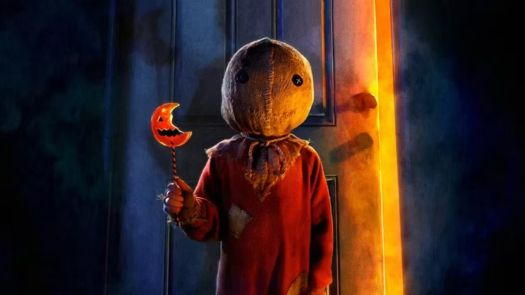
Even the lollipop is a thread that runs through more than one story.
An early Legendary Pictures film, this movie is a kind of throwback to Creepshow and other ’80s movies and TV shows, but with a more integrated and cinematic feel.
We start with a very random, very standard horror movie kill, as a young couple comes home from a night of revelry, and the wife insists that the decorations be cleaned up before her mother gets there in the morning. He demurs so she starts cleaning things up on her own, apparently unaware that There Are Rules.
It’s not novel, but horror movies (of this sort) are like musicals: It’s not that you’re looking to be surprised to discover someone bursting into song-and-dance, it’s the quality of the song-and-dance. This first kill is fine, a bit above average in terms of visuals, but nicely revisited at the end where things come together and we see the scene recontextualized after the other stories. (“Three hours earlier…”)

Brett Kelly, known through the ’90s as “That Fat Kid,” works regularly today as a slightly doughy 30-something actor.
From here we have Dylan Baker as a serial killer, comically interrupted by neighbor Brian Cox and others as he tries to bury his latest kill. This segues into a town party where, dressed as a vampire, he kills a female partygoer. At the same party Anna Paquin’s and her slutty friends visit a costume store (because we all buy costumes on Halloween night, right?) and pick up guys for a later shindig, leaving virginal Anna alone. We break for a ghost tale of children visiting an old quarry where a school bus full of “unspecified special children” are sent to their demise at the behest of their parents, and their vengeful ghosts remain. Then we finish the Paquin story and cut back to Brian Cox who, lives across the street from our first vignette couple and finds himself terrorized by tiny Sam Hain because he sends his dog out in a Halloween mask to scare the trick-or-treaters, rather than giving them candy. (Now, he steals their candy, which to me is a very Halloween thing to do, but Sam Hain disagrees and tortures Cox for about 15 minutes.) Close on opening vignette and final coda.
For stories, this stuff is all very stock, but there are things that elevate this and make it worthy of a watch. Most famous for writing X-Men 2: X-Men United and Godzilla: King of the Monsters, my favorite work by writer/director Michael Dougherty is the under-rated Krampus, but it’s really his direction here that makes this more enjoyable than a typical horror anthology, as well as kick-ass set design, music and acting.
The typical situation with a horror anthology is: We have this great idea for a story but it’s only about 40 minutes long. So we package it with two or three twenty-minute throwaways, and we got ourselves a feature!
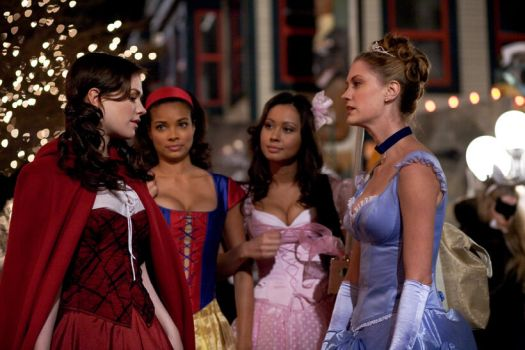
Cute girls, but if this had been made in the ’70s, they’d all have been topless in the first 20 minutes.
These stories are all in the “fine” category. The twists aren’t likely to shock you, although the Dylan Baker one is kind of “nice”. But the threads of the first story feeding into the second and the fourth, and the fourth story feeds into the third story and the bookend story (which might be considered just a part of the fourth)—the whole thing coalesces like a classic “Simpsons” storyline and becomes satisfying in a way the basic stories would not be by themselves.
Meanwhile, this movie looks great in 4K. Taking place over a few hours on Halloween night, gorgeously lit with alternating bright orange-and-black and vague, misty blue-and-green, this feels like a bookend to the horror tradition that started in the late ’70s with Halloween and, yes, Creepshow, down to comic-book-style title cards. It’s R-rated but has basically vestigial nudity and mostly implied gore, with black humor running through some of the most “horrific” elements.
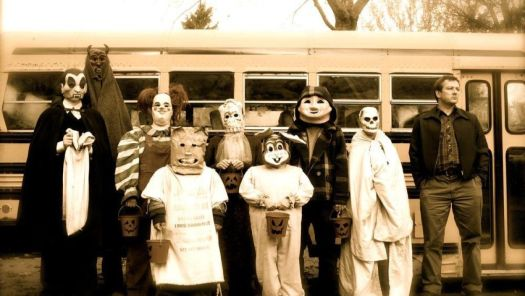
This photograph recalls “The Shining” to me. What do you think?
Great traditional score by Douglas Pipes (also of Krampus and Monster House).
It’s fun and it’s not boring. Even if it’s sort of a throwback (for 2007, to say nothing of today), it was clearly done with a lot of love and sincerity.
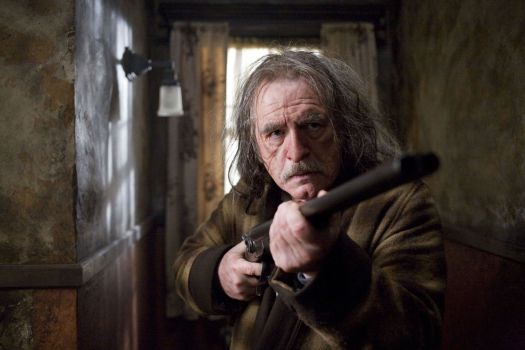
“Make me look like John Carpenter,” quoth Brian Cox, who goes on to recite a very famous line from “The Thing”.
And now for some background info: Researching it, it appears that writer/directory Dougherty had no plans to direct originally. In fact, he had Tobe Hooper, George Romero, Stan Winston and John Carpenter set to direct the segments, but in the end not a single studio wanted to buy it.
Every studio passed on it. Not every studio, but I remember one keynote we got was, ‘Nobody wants to see vampires, werewolves or zombies because they’re too old-fashioned
This would’ve been in the early 2000s, around the time of 28 Days Later (2002) and not long before Twilight (2008) and Walking Dead (2010). This truly encapsulates Hollywood wisdom.
On the plus side, I’m not sure this film would’ve been as good if the four stories had been as segmented as they’d have to have been with four separate directors. Either way, we’ll never know, since Carpenter is the last man standing of those four.
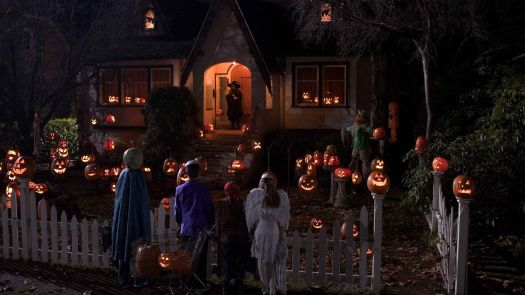
Look at that! Pumpkins! How Halloween can you get?
